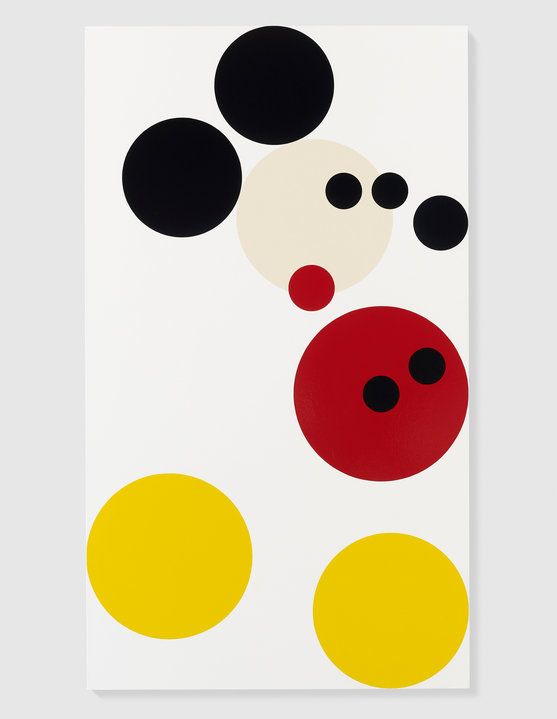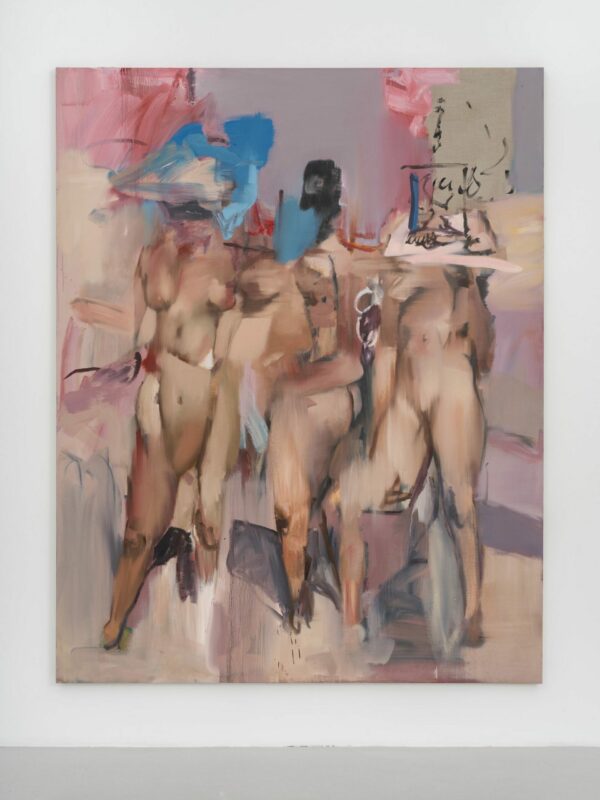
Damien Hirst, ‘Mickey’ (2012) ‘Mickey’ will be on view to the public as part of Christie’s auction’s pre-sale exhibition from Saturday 8th February. Photographed by Prudence Cuming Associates © Damien Hirst and Science Ltd. All rights reserved, DACS 2014
Damien Hirst has made close to 1400 Spot Paintings, the latest of which is Mickey Mouse (2012). The first 1365 are chronicled in a hotly anticipated, much-delayed catalogue raisonné, The Complete Spot Paintings 1986-2011. The catalogue is supposed to bolster market confidence in the series by proving they are less numerous than rumoured, but the value of a Spot Painting is about so much more than numbers. It is a matter of seeing a given Spot Painting as a unique artwork which has a place in both a series and an art historical narrative.
The Spot Paintings are conceptually brilliant works of art insofar as their meaning is perfectly expressed by a few simple rules of production. The gaps between spots must be equal to the size of the spots, no colour is to be repeated on a single canvas, so that this formula can be realised forever. That pure mathematical infinity expresses the immortality of the Spot Painting series and that delusion of immortality promised by the pharmaceuticals after which the majority of the paintings are named.
How, then, do we value something so numerous? It is thought that their sheer proliferation devalues them on the market, but this could only be the case if you refuse to recognise that each Spot Painting is a unique work of art, aesthetically different from all the others with which it shares a common conceptual connection. Instead of recognising this aesthetic fact, the market currently takes a pseudo-historical approach by attaching higher prices to older works, as if the whole of history had been sped up and an early nineties Spot Painting has the lofty status of a relic.
The better approach, however, is appeal to the market’s desire for intellectual or cultural respectability by viewing the Spot Paintings as unique artworks with differential cultural values attached to them, which in turn determines their market values. In her book, High Price, Isabelle Graw draws an instructive distinction between symbolic and economic value, whereby the former is the status of art as a cultural product and the latter is the numbers attached to it for the purpose of exchange. She argues that they are distinct values which are intimately connected, since although a high price does not guarantee the work is culturally valuable, the right critical response to a work can bolster its economic value.
On this model, the jury remains out on the cultural value of the series as a totality, until we can settle debates about whether it is a serious art-historical evolution of, say, Kusama’s spot paintings, although it is my suspicion that Hirst will win this debate since his conceptual rigour and aesthetic iconoclasm will survive the ruins of history. But we can say that the cultural value of a given Spot Painting determines its economic value by appealing to the uniqueness of the works as situated within an essentially rule-governed series. I propose that here value is determined by deviation from series: when everything looks so similar, the ones that stand out are the ones that brazenly flout the conceptual rule such as Mickey Mouse, Controlled Substance Key Paintings and Ronnie O’Sullivan’s fastest ever 147 break. These works have a higher cultural value because they are simultaneously part of the series and they transcend it.
Interestingly, the deviant Spot Paintings are often produced for charity or for private commissions, which might increase their economic value in the future, but it is the fact that they differ so markedly from their brethren that makes them desirable cultural products. Indeed, the entire series is sustained by these deviations because any respectable collection of Spot Paintings would want to include one of them. So this recent Mickey Mouse Spot Painting, far from being a lazy appropriation of a Hirst icon to fulfil a moral vacuum, not only turns out to be one of the more overall valuable works, but also points us in the direction of understanding how a Spot Painting might achieve a cultural value to match its baffling economic value.
Words: Daniel Barnes







